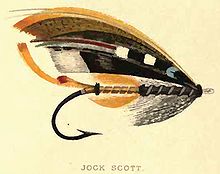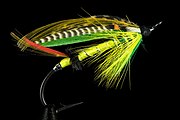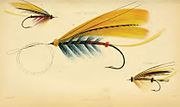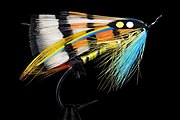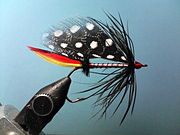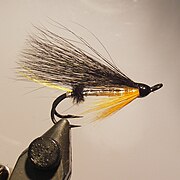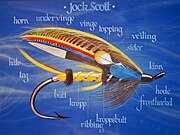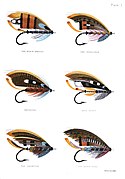
Fly tying is the process of producing an artificial fly used by fly fishing anglers to catch fish. Fly tying is a manual process done by a single individual using hand tools and a variety of natural and manmade materials that are attached to a hook. Although the recent history of fly tying dates from the middle 1800s, fly tyers were engaged in tying flies since at least 200 AD.
Cosseboom is a type of artificial fly, commonly used in fly fishing to catch salmon. It was created by the American angler John C. Cosseboom of Woonsocket, Rhode Island in around 1923, for use on the Margaree River in Nova Scotia, Canada.

The Muddler Minnow is a popular and versatile artificial fly of the streamer type used in fly fishing and fly tying.

An artificial fly or fly lure is a type of fishing lure, usually used in the sport of fly fishing. In general, artificial flies are an imitation of aquatic insects that are natural food of the target fish species the fly fishers try to catch. Artificial flies are constructed by fly tying, in which furs, feathers, thread or any of very many other materials are tied onto a fish hook.

The Grey Ghost Streamer is an artificial fly, of the streamer type. Its primary function is to imitate smelt. The streamer's wing gives it a swimming action while trolling or using the Dead Drift technique.

The Salmon Fly - How to Dress It and How to Use It is a fly fishing book written by George M. Kelson published in London in 1895 by Messers. Wyman & Sons, Limited. This Victorian guide to fly fish tying built up the illusion that angling for salmon required feathers of exotic bird species.
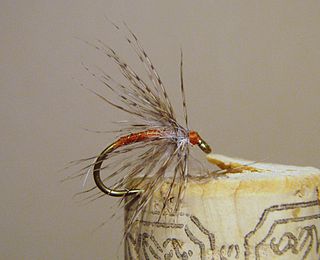
The Partridge and Orange is an artificial fly commonly categorized as a wet fly or soft hackle and is fished under the water surface. The fly is a very well known fly with its roots set firmly in English angling history. It is an impressionistic pattern fished successfully during caddis hatches and spinner falls. The Partridge and Orange is traditionally a trout and grayling pattern but may be used for other aquatic insect feeding species.

The Royal Coachman is an artificial fly that has been tied as a wet fly, dry fly and streamer pattern. Today, the Royal Coachman and its variations are tied mostly as dry flies and fished floating on the water surface. It is a popular and widely used pattern for freshwater game fish, particularly trout and grayling. Large streamer versions are also used for winter steelhead and Atlantic salmon.

The Adams is a traditional dry fly primarily used for trout. It is considered a general imitation of an adult mayfly, flying caddis or midge. It was designed by Leonard Halladay from Mayfield, Michigan in 1922, at the request of his friend Charles Adams. The Adams has been considered one of the most popular, versatile, effective and best selling dry flies since its creation.
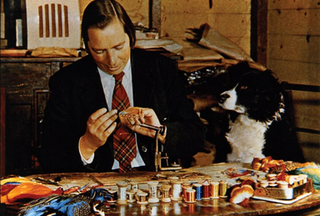
Rosina Megan Boyd was a British fly tyer most noted for her Atlantic salmon flies. She lived most of her adult life in a small cottage in Kintradwell, near Brora, Scotland. Boyd, a renowned figure in the Scottish Highlands, was known for her fly tying skills, eccentric style, and service during World War II. Despite never fishing herself, Boyd's precision and quality in fly tying made her creations sought after by local anglers. She invented a traditional pattern called "The Megan Boyd," and her work earned her the British Empire Medal in 1971. Boyd retired at 70 due to failing eyesight but remained a major supporter of the North Atlantic Salmon Fund until her death in 2001.
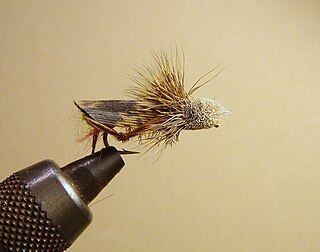
Dave's Hopper is an artificial fly used for fly fishing, designed to imitate adult grasshoppers and other Orthoptera species. It is considered a dry fly terrestrial pattern. It was designed by fly tyer and angler Dave Whitlock, and combines the best aspects of Joe's Hopper and Muddler Minnow patterns.

Parks' Salmonfly is a traditional dry fly imitating adults of the family of giant stoneflies or salmonflies (Pteronarcyidae). The most commonly imitated species is Pteronarcys californica or salmonfly common throughout Western North America from British Columbia to California.
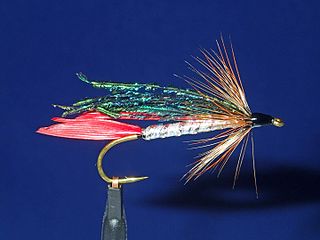
The Alexandra wet fly is an artificial fly. Also known as the Lady of the Lake, the fly was named by English angler Major William Greer Turle to honour Alexandra, Princess of Wales. The fly is distinguished by the heavy peacock herl wing and silver body which makes the fly resemble a small baitfish or fry. The Alexandra proved to be a very effective fly for trout in lakes and streams in England and Scotland in the late 19th and early 20th century. Many fly fishing purists derided the fly and its use was once banned on many English waters.

The Stimulator is a dry fly popularized by angler, fly tyer and author Randall Kaufmann to imitate large adult stoneflies.

The Sakasa Kebari or reverse-hackle fly, is an artificial fly most associated with the Japanese style of tenkara fishing but can be used in most freshwater fly fishing. The Sakasa Kebari is usually defined by firstly, its reverse hackle and secondly, by its simplicity as compared to western style flies. This fly was originally created to be used in the small, high gradient streams in Japan while fishing for native trout and char.

The Red Tag is an artificial fly originally designed as a dry fly for grayling and trout in the north country of England. The fly pattern, when introduced into Australia, particularly Tasmania, became extremely successful and popular for brown trout and remains today as one of the most essential flies for Australian fly anglers.

George Mortimer Kelson was an English amateur cricketer, sport angler, and self-promotional author who played for Kent County Cricket Club in the 19th century.

The Prince Nymph is a nymph attractor wet fly used in fly fishing. It was created by Doug Prince of Oakland, California in the 1930s. It was originally known as the "Brown Forked Tail" and tied without a bead head and used black ostrich herl instead of peacock herl in the body. This fly is weighted. It is productive and popular fly and numerous variations have been created.

The Wulff series of dry flies evolved from a dry fly style conceived by angler Lee Wulff in the 1930s.

The Humpy fly is a popular and effective dry fly used by fly anglers for trout in fast-water conditions.
